A Study on the Influence of Air Pollution on Temperature Forecast Skill Based on Operational Weather Forecast in BTH Region
Abstract
1. Introduction
2. Data and Method
2.1. Research Area and Period
2.2. NWP Forecast Data and Observations
2.3. Method
3. Results
3.1. Characteristics of Pollutant Concentration Changes over the BTH in January and February 2020
3.2. Differences in Temperature Forecast Skills between January and February 2020
4. Discussion
5. Conclusions
Author Contributions
Funding
Institutional Review Board Statement
Informed Consent Statement
Data Availability Statement
Conflicts of Interest
References
- Zhang, Y.; Chen, X.; Yu, S.; Wang, L.; Li, Z.; Li, M.; Liu, W.; Li, P.; Rosenfeld, D.; Seinfeld, J.H. City-level air quality improvement in the Beijing-Tianjin-Hebei region from 2016/17 to 2017/18 heating seasons: Attributions and process analysis. Environ. Pollut. 2021, 274, 116523. [Google Scholar] [CrossRef]
- Luo, Y.H.; Zhao, T.L.; Yang, Y.J.; Zong, L.; Kumar, K.P.; Wang, H.; Meng, K.; Zhang, L.; Lu, S.; Xin, Y.S. Seasonal changes in the recent decline of combined high PM2.5 and O3 pollution and associated chemical and meteorological drivers in the Beijing–Tianjin–Hebei region. China Sci. Total Environ. 2022, 838, 156312. [Google Scholar] [CrossRef]
- Liu, Y.; Tian, J.W.; Zheng, W.F.; Yin, L.R. Spatial and temporal distribution characteristics of haze and pollution particles in China based on spatial statistics. Urban Clim. 2022, 41, 101031. [Google Scholar] [CrossRef]
- National Bureau of Statistics of China. China Statistical Yearbook (2021); China Statistics Press: Beijing, China, 2021. [Google Scholar]
- Gao, M.; Liu, Z.R.; Zheng, B.; Ji, D.S.; Sherman, P.; Song, S.J.; Xin, J.Y.; Liu, C.; Wang, Y.S.; Zhang, Q.; et al. China’s emission control strategies have suppressed unfavorable influences of climate on wintertime PM2.5 concentrations in Beijing since 2002. Atmos. Chem. Phys. 2020, 20, 497–1505. [Google Scholar] [CrossRef]
- Zhang, Z.Y.; Zhao, X.J.; Mao, R.; Xu, J.; Kim, S.J. Predictability of the winter haze pollution in Beijing–Tianjin–Hebei region in the context of stringent emission control. Atmos. Pollut. Res. 2022, 13, 101392. [Google Scholar] [CrossRef]
- Zhao, N.; Elshareef, H.; Li, B.W.; Wang, B.M.; Jia, Z.Z.; Zhou, L.; Liu, Y.; Sultan, M.; Dong, R.J.; Zhou, Y.G. The efforts of China to combat air pollution during the period of 2015–2018: A case study assessing the environmental, health and economic benefits in the Beijing-Tianjin-Hebei and surrounding “2 + 26” regions. Sci. Total Environ. 2022, 853, 158437. [Google Scholar] [PubMed]
- Zhang, Z.Y.; Zhang, X.L.; Gong, D.Y.; Kim, S.J.; Mao, R.; Zhao, X.J. Possible influence of atmospheric circulations on winter hazy pollution in Beijing-Tianjin-Hebei region, northern China. Atmos. Chem. Phys. 2016, 16, 561–571. [Google Scholar] [CrossRef]
- Zhai, S.X.; Jacob, D.J.; Wang, X.; Shen, L.; Li, K.; Zhang, Y.Z.; Gui, K.; Zhao, T.L.; Liao, H. Fine particulate matter (PM2.5) trends in China, 2013–2018: Separating contributions from anthropogenic emissions and meteorology. Atmos. Chem. Phys. 2019, 19, 11031–11041. [Google Scholar]
- Kumar, R.P.; Perumpully, S.J.; Samuel, C.; Gautam, S. Exposure and health: A progress update by evaluation and scientometric analysis. Stoch. Environ. Res. Risk Assess. 2023, 37, 453–465. [Google Scholar]
- Yin, L.; Wang, L.; Huang, W.; Tian, J.; Liu, S.; Yang, B.; Zheng, W. Haze Grading Using the Convolutional Neural Networks. Atmosphere 2022, 13, 522. [Google Scholar] [CrossRef]
- Intergovernmental Panel on Climate Change (IPCC). Climate Change 2021: The Physical Science Basis; Cambridge University Press: Cambridge, UK, 2021. [Google Scholar]
- Wang, Y.; Khalizov, A.; Zhang, R. New directions: Light absorbing aerosols and their atmospheric impacts. Atmos. Environ. 2013, 81, 713–715. [Google Scholar]
- Ding, A.J.; Huang, X.; Nie, W.; Sun, J.N.; Kerminen, V.M.; Petäjä, T.; Su, H.; Cheng, Y.; Yang, X.Q.; Wang, M.; et al. Enhanced haze pollution by black carbon in megacities in China. Geophys. Res. Lett. 2016, 43, 2873–2879. [Google Scholar] [CrossRef]
- Li, Z.Q.; Guo, J.P.; Ding, A.J.; Liao, H.; Liu, J.J.; Sun, Y.L.; Wang, T.J.; Xue, H.W.; Zhang, H.S.; Zhu, B. Aerosol and boundary-layer interactions and impact on air quality. Natl. Sci. Rev. 2017, 4, 810–833. [Google Scholar]
- Watson-Parris, D.; Bellouim, N.; Deaconu, L.T.; Schutgens, N.A.J.; Youshioka, M.; Regayre, L.A.; Pringle, K.J.; Johnson, J.S.; Smith, C.J.; Carslaw, K.S.; et al. Constraining uncertainty in aerosol direct forcing. Geophys. Res. Lett. 2020, 47, e2020GL087141. [Google Scholar] [CrossRef]
- Kumar, R.P.; Brema, J.; Samuel, C.; Gautam, S. A bibliometric and scientometric: Analysis towards global pattern and trends related to aerosol and precipitation studies from 2002 to 2022. Air Qual. Atmos. Health 2023, 16, 613–628. [Google Scholar]
- Hohenegger, C.; Vidale, P.L. Sensitivity of the European climate to aerosol forcing as simulated with a regional climate model. J. Geophys. Res. 2005, 110, D06201. [Google Scholar] [CrossRef]
- Zubler, E.M.; Lohmann, U.; Lüthi, D.; Schär, C. Intercomparison of aerosol climatologies for use in a regional climate model over Europe. Geophys. Res. Lett. 2011, 38, L15705. [Google Scholar] [CrossRef]
- Makar, P.A.; Gong, W.; Milbrandt, J.; Hogrefe, C.; Zhang, Y.; Curci, G.; Zabkar, R.; Im, U.; Balzarini, A.; Baro, R.; et al. Feedbacks between air pollution and weather, Part I: Effects on weather. Atmos. Environ. 2015, 115, 442–469. [Google Scholar]
- Makar, P.A.; Gong, W.; Hogrefe, C.; Zhang, Y.; Curci, G.; Zabkar, R.; Milbrandt, J.; Im, U.; Balzarini, A.; Baro, R.; et al. Feedbacks between air pollution and weather, Part II: Effects on chemistry. Atmos. Environ. 2015, 115, 499–526. [Google Scholar]
- de Perez, E.C.; van Aalst, M.; Bischiniotis, K.; Mason, S.; Nissan, H.; Pappenberger, F.; Stephens, E.; Zsoter, E.; van den Hurk, B. Global predictability of temperature extremes. Environ. Res. Lett. 2018, 13, 054017. [Google Scholar] [CrossRef]
- Benedetti, A.; Vitart, F. Can the direct effect of aerosols improve subseasonal predictability? Mon. Weather. Rev. 2018, 146, 3481–3498. [Google Scholar] [CrossRef]
- Choi, I.J.; Park, R.S.; Lee, J. Impacts of a newly-developed aerosol climatology on numerical weather prediction using a global atmospheric forecasting model. Atmos. Environ. 2019, 197, 77–91. [Google Scholar] [CrossRef]
- Jeong, G.R. Weather Effects of Aerosols in the Global forecast Model. Atmosphere 2020, 11, 850. [Google Scholar] [CrossRef]
- Huang, X.; Ding, A. Aerosol as a critical factor causing forecast biases of air temperature in global numerical weather prediction models. Sci. Bull. 2021, 66, 1917–1924. [Google Scholar] [CrossRef] [PubMed]
- Chen, Q.X.; Huang, C.L.; Yuan, Y.; Tan, H.P. Influence of COVID-19 Event on Air Quality and their Association in Mainland China. Aerosol Air Qual. Res. 2020, 20, 1541–1551. [Google Scholar] [CrossRef]
- Filonchyk, M.; Hurynovich, V.; Yan, H.; Gusev, A.; Shpilevskaya, N. Impact Assessment of COVID-19 on Variations of SO2, NO2, CO and AOD over East China. Aerosol Air Qual. Res. 2020, 20, 1530–1540. [Google Scholar] [CrossRef]
- Bauwens, M.; Compernolle, S.; Stavrakou, T.; Müller, J.-F.; Gent, J.; Eskes, H.; Levelt, P.F.; van der, A.R.; Veefkind, J.P.; Vlietinck, J.; et al. Impact of coronavirus outbreak on NO2 pollution assessed using TROPOMI and OMI observations. Geophys. Res. Lett. 2020, 47, e2020GL087978. [Google Scholar] [CrossRef]
- Tian, J.W.; Liu, Y.; Zheng, W.F.; Yin, L.R. Smog prediction based on the deep belief—BP neural network model (DBN-BP). Urban Clim. 2022, 41, 101078. [Google Scholar] [CrossRef]
- Xu, Z.; Liu, Z.; Tian, J.; Liu, Y.; Pan, H.; Liu, S.; Yang, B.; Yin, L.; Zheng, W. Classification of Urban Pollution Levels Based on Clustering and Spatial Statistics. Atmosphere 2022, 13, 494. [Google Scholar] [CrossRef]
- Shang, K.L.; Chen, Z.Y.; Liu, Z.X.; Song, L.H.; Zheng, W.F.; Yang, B.; Liu, S.; Yin, L.R. Haze Prediction Model Using Deep Recurrent Neural Network. Atmosphere 2021, 12, 1625. [Google Scholar] [CrossRef]
- Barker, D.; Huang, X.Y.; Liu, Z.; Auligné, T.; Zhang, X.Y.; Rugg, S.; Ajjaji, R.; Bourgeois, A.; Bray, J.; Chen, Y.; et al. The weather research and forecasting model’s community variational/ensemble data assimilation system: WRFDA. Bull. Am. Meteorol. Soc. 2012, 93, 831–843. [Google Scholar] [CrossRef]
- Xie, Y.H.; Fan, S.Y.; Chen, M.; Shi, J.C.; Zhong, J.Q.; Zhang, X.Y. An assessment of satellite radiance data assimilation in RMAPS. Remote Sens. 2019, 11, 54. [Google Scholar] [CrossRef]
- Ceppi, P.; McCoy, D.T.; Hartmann, D.L. Observational evidence for a negative shortwave cloud feedback in middle to high latitudes. Geophys. Res. Lett. 2016, 43, 1331–1339. [Google Scholar] [CrossRef]
- Zelinka, M.D.; Zhou, C.; Klein, S.A. Insights from a refined decomposition of cloud feedbacks. Geophys. Res. Lett. 2016, 43, 9259–9269. [Google Scholar] [CrossRef]

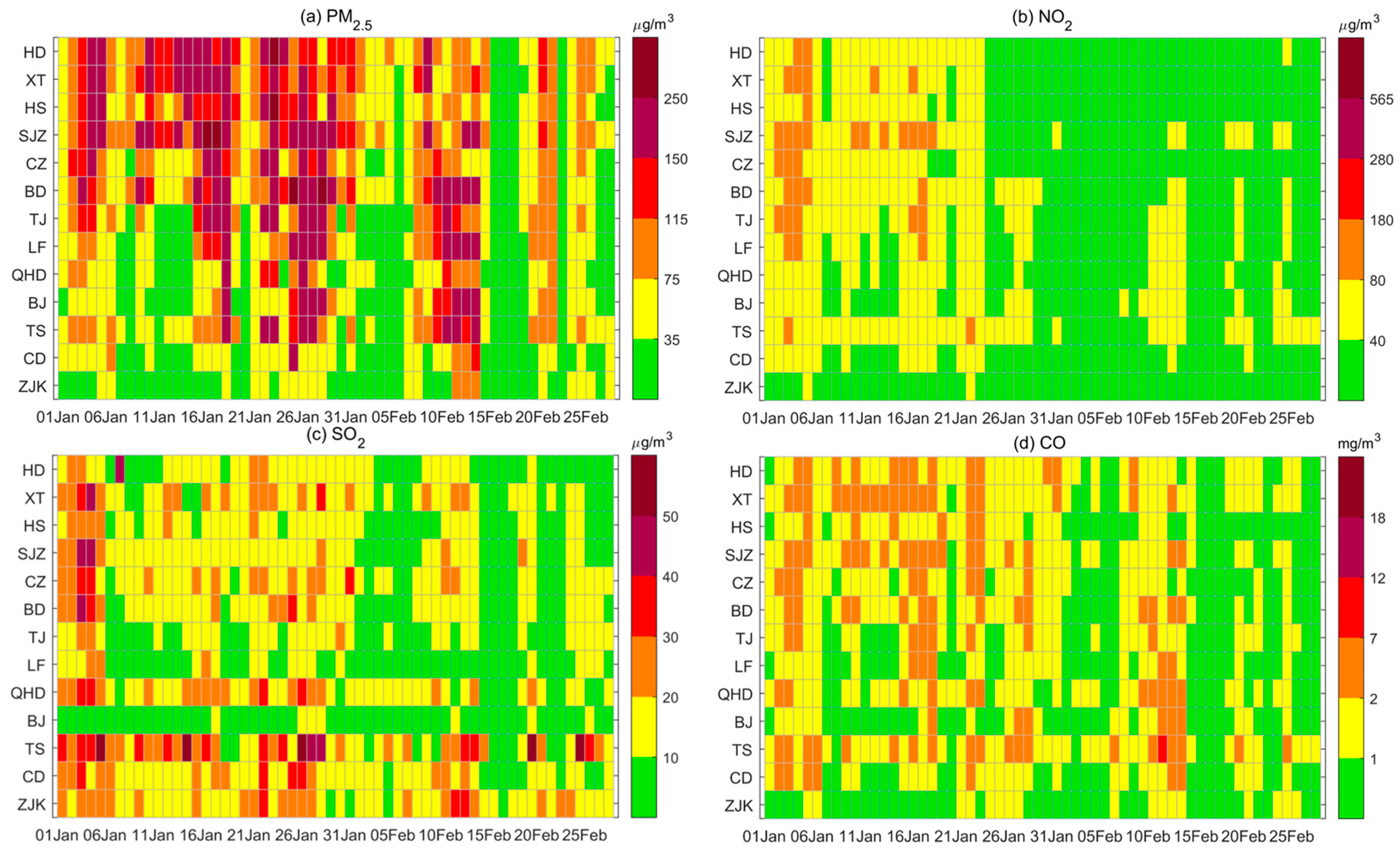
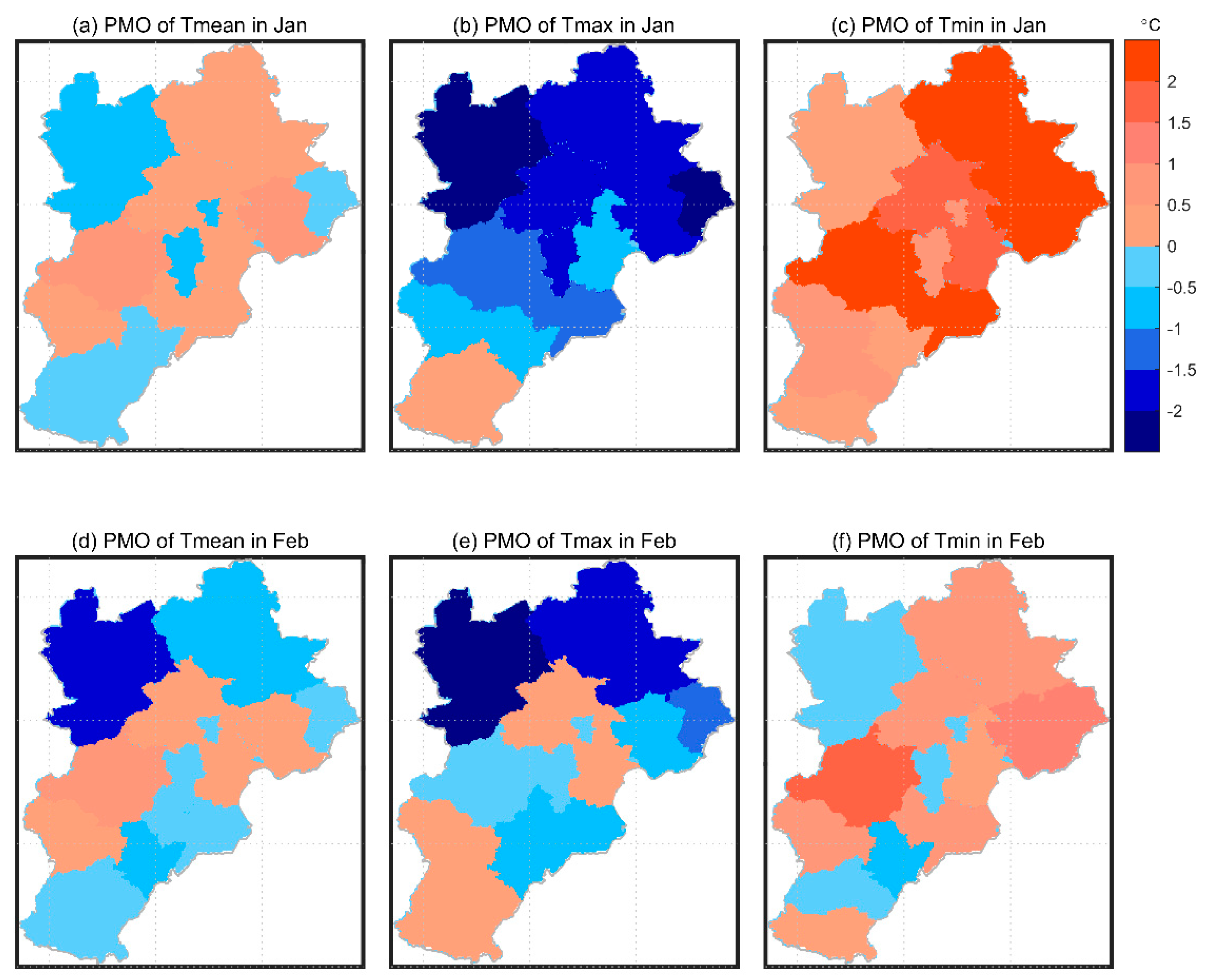
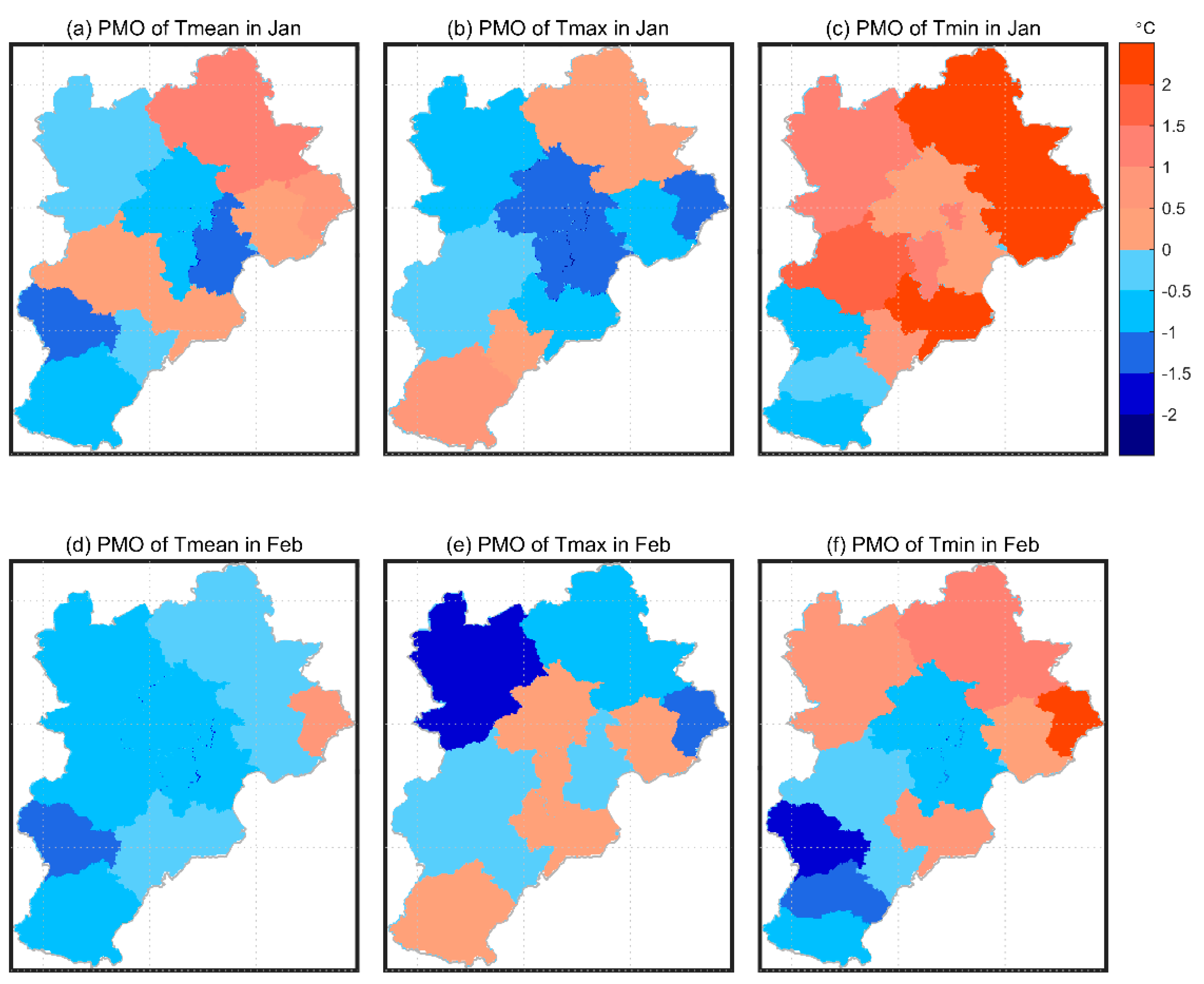
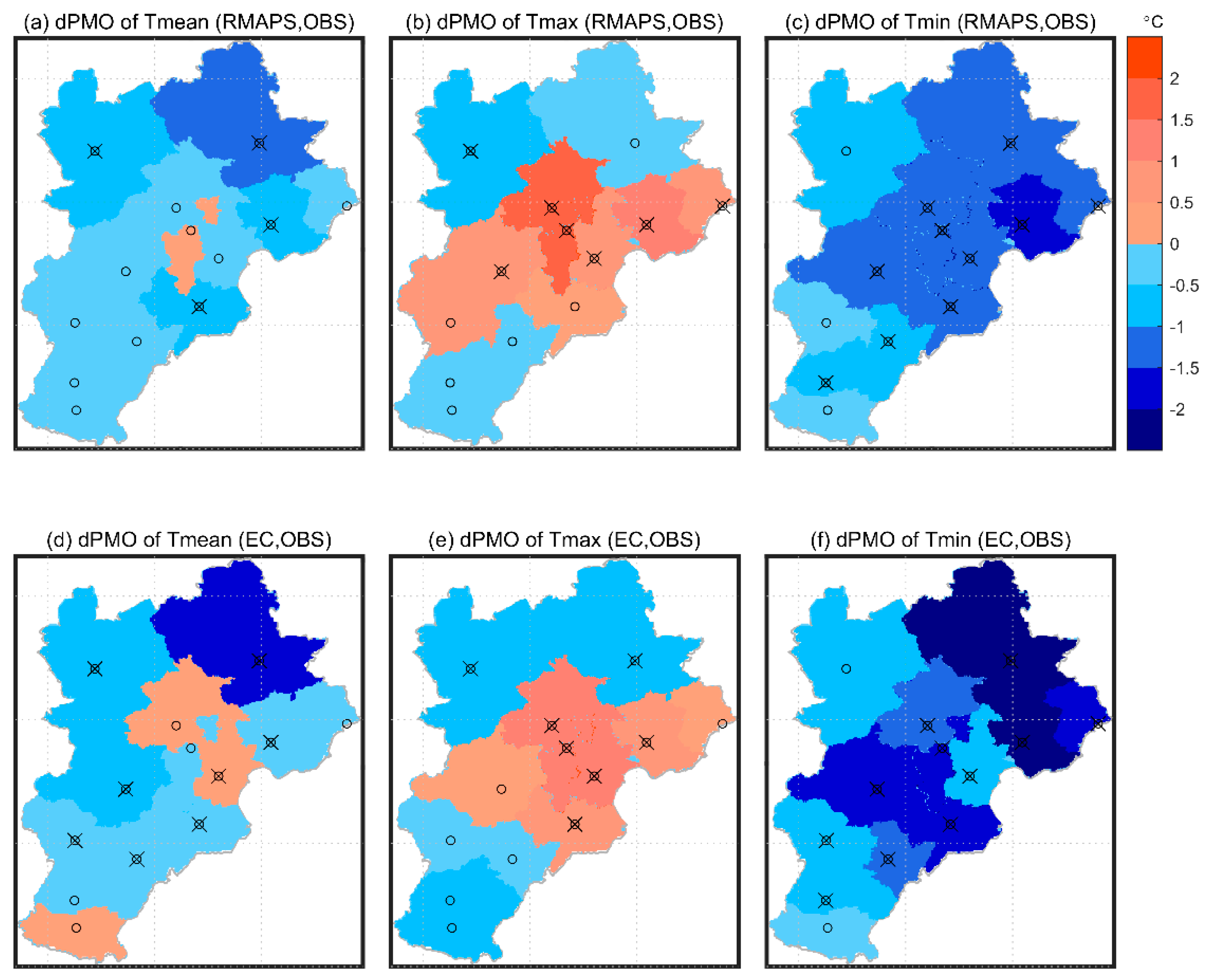
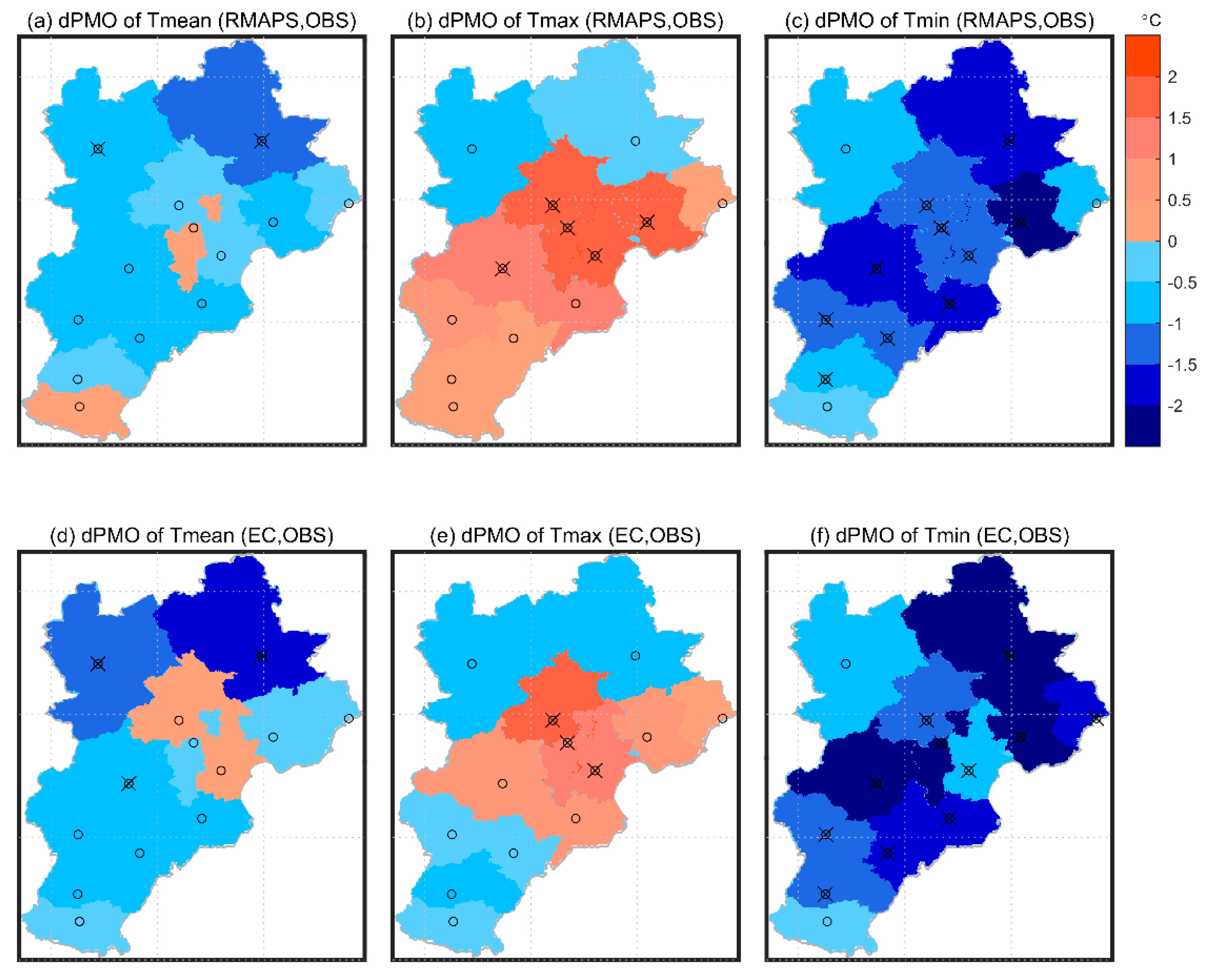
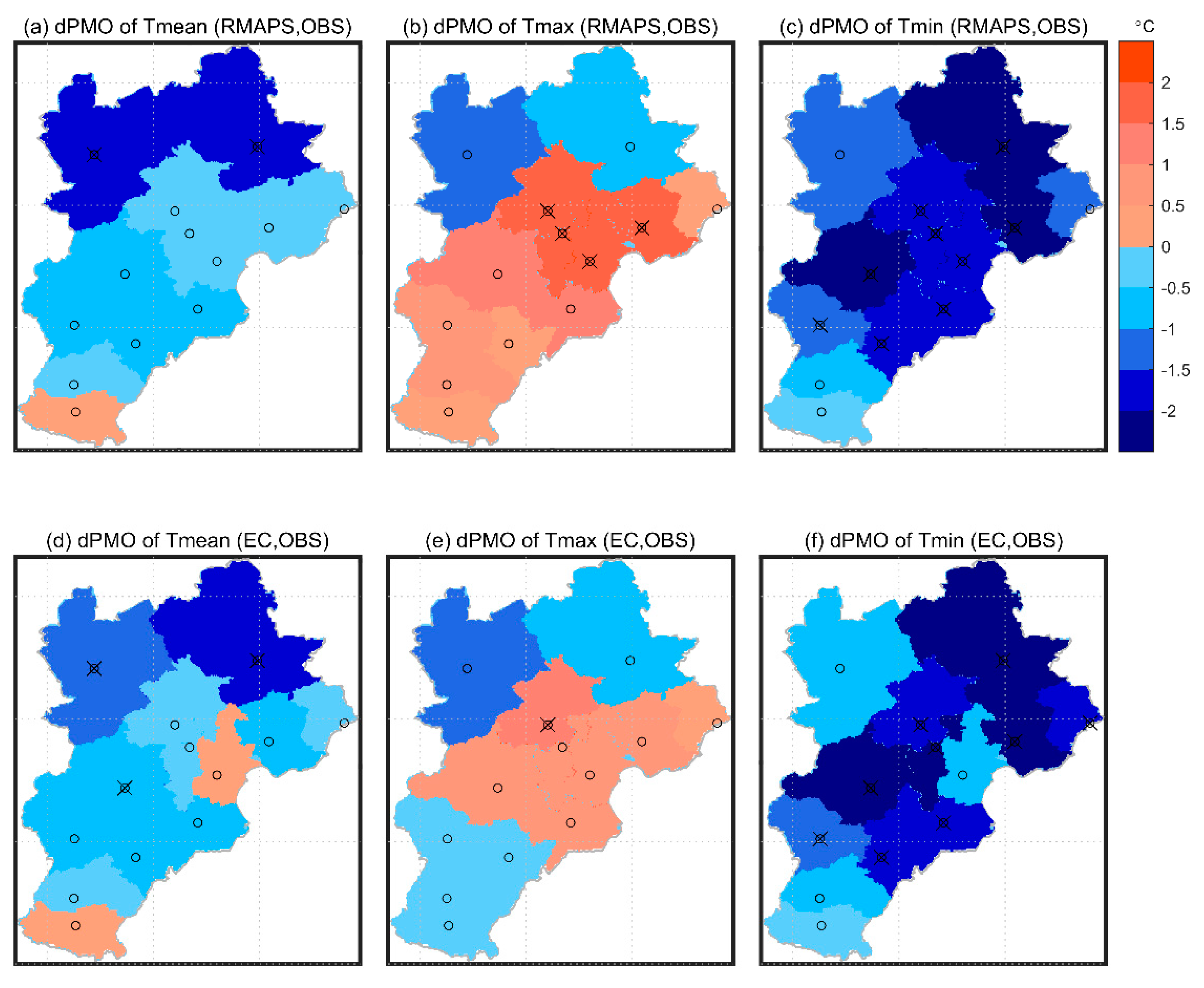
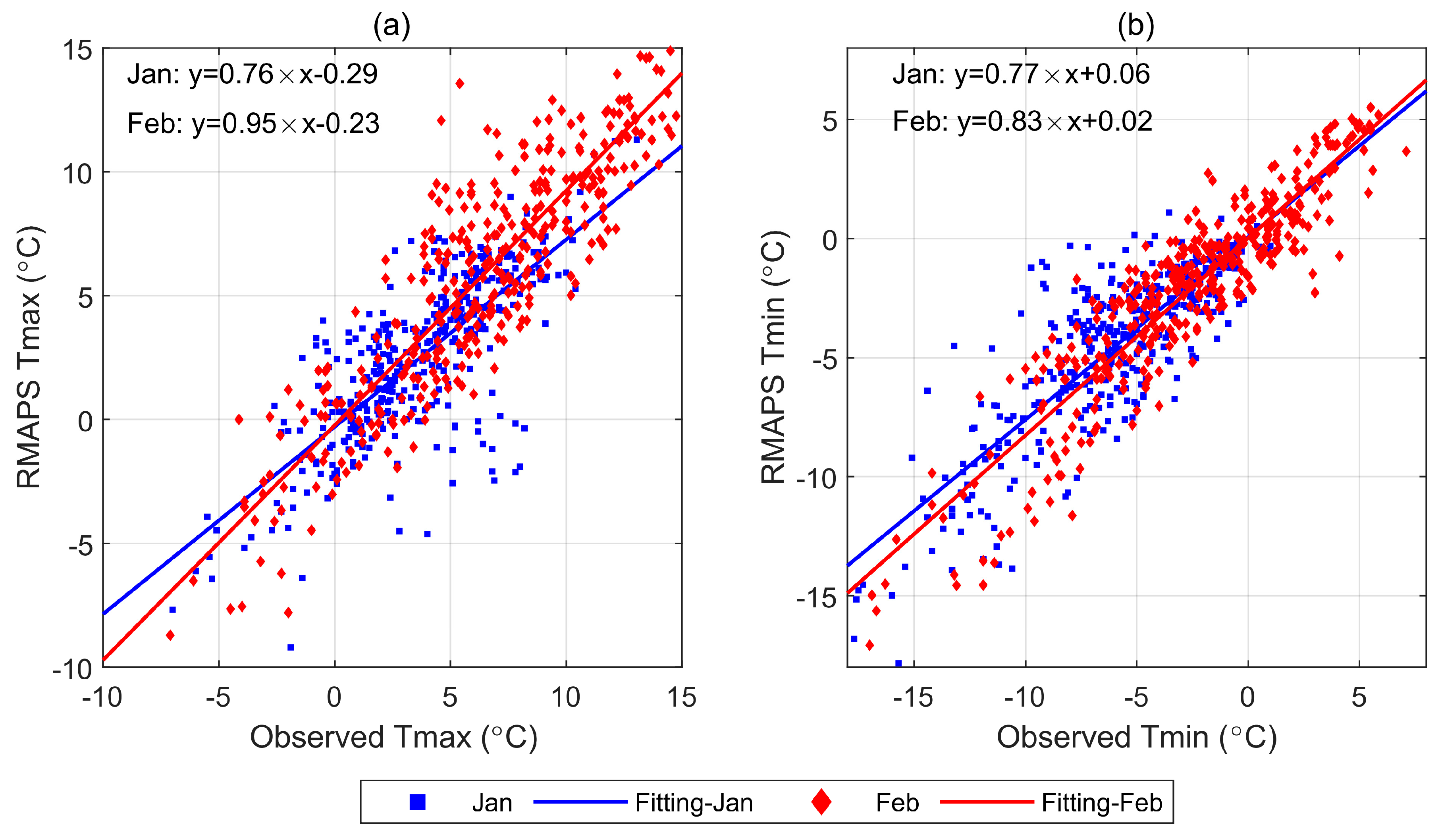
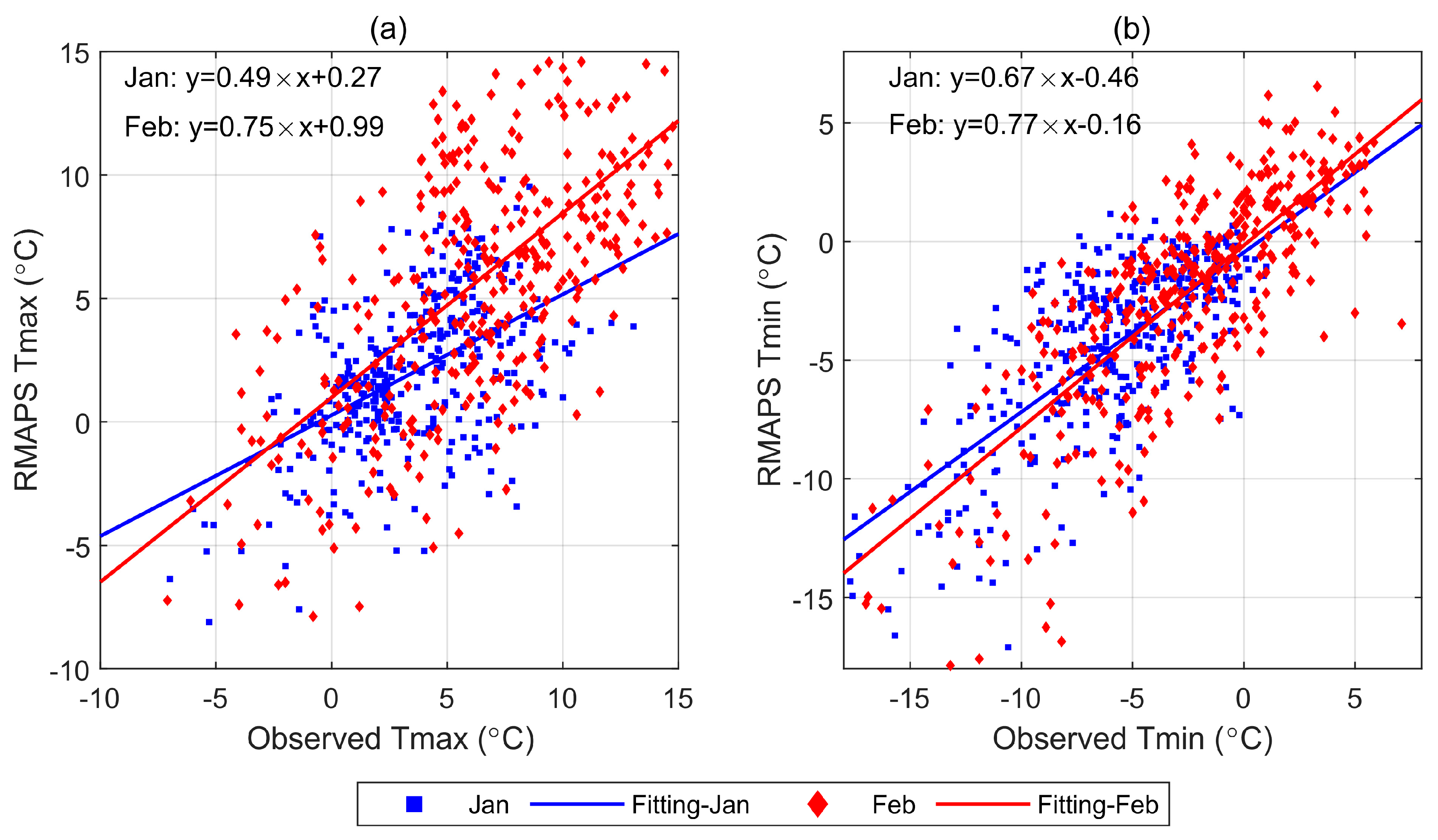

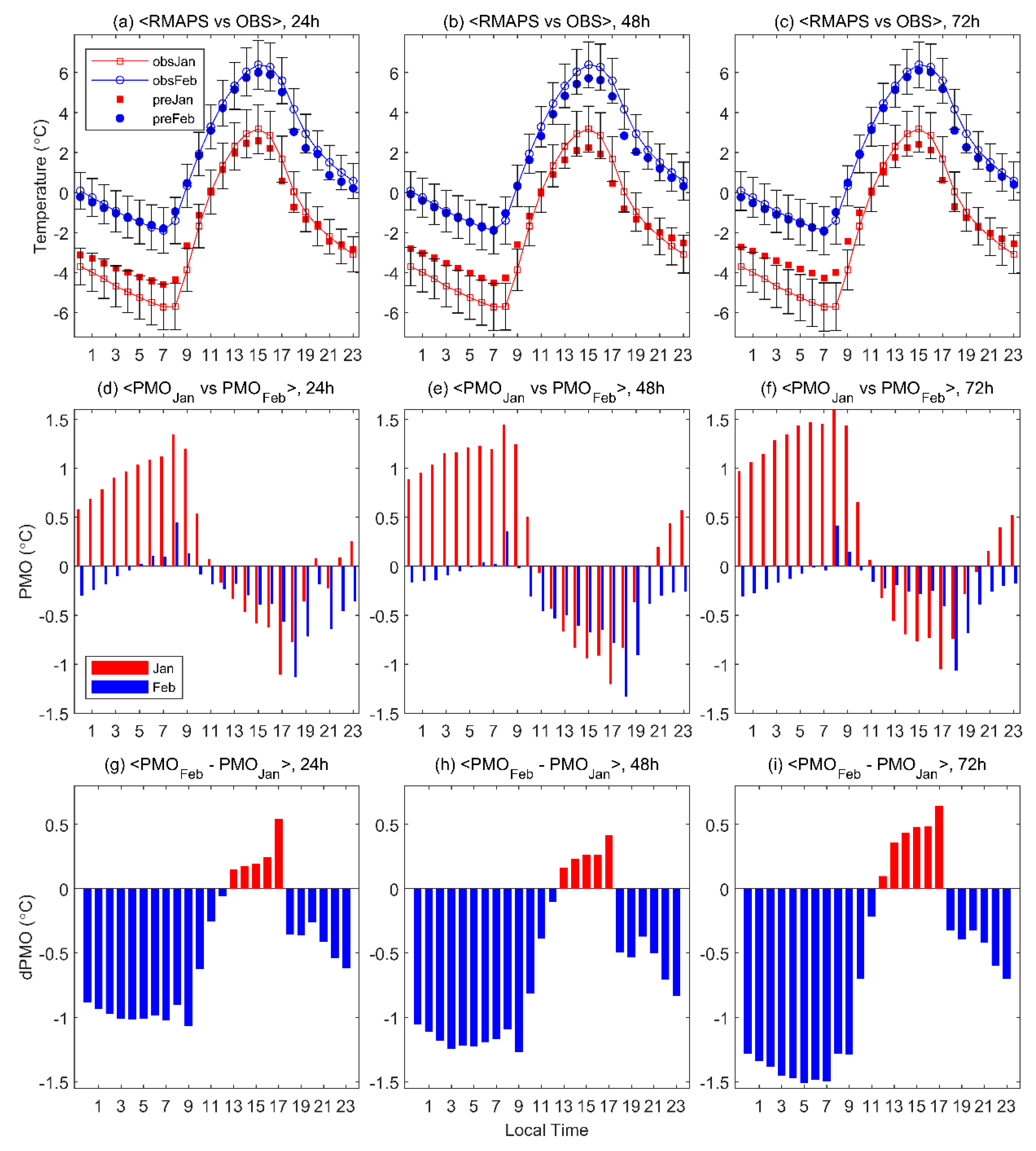
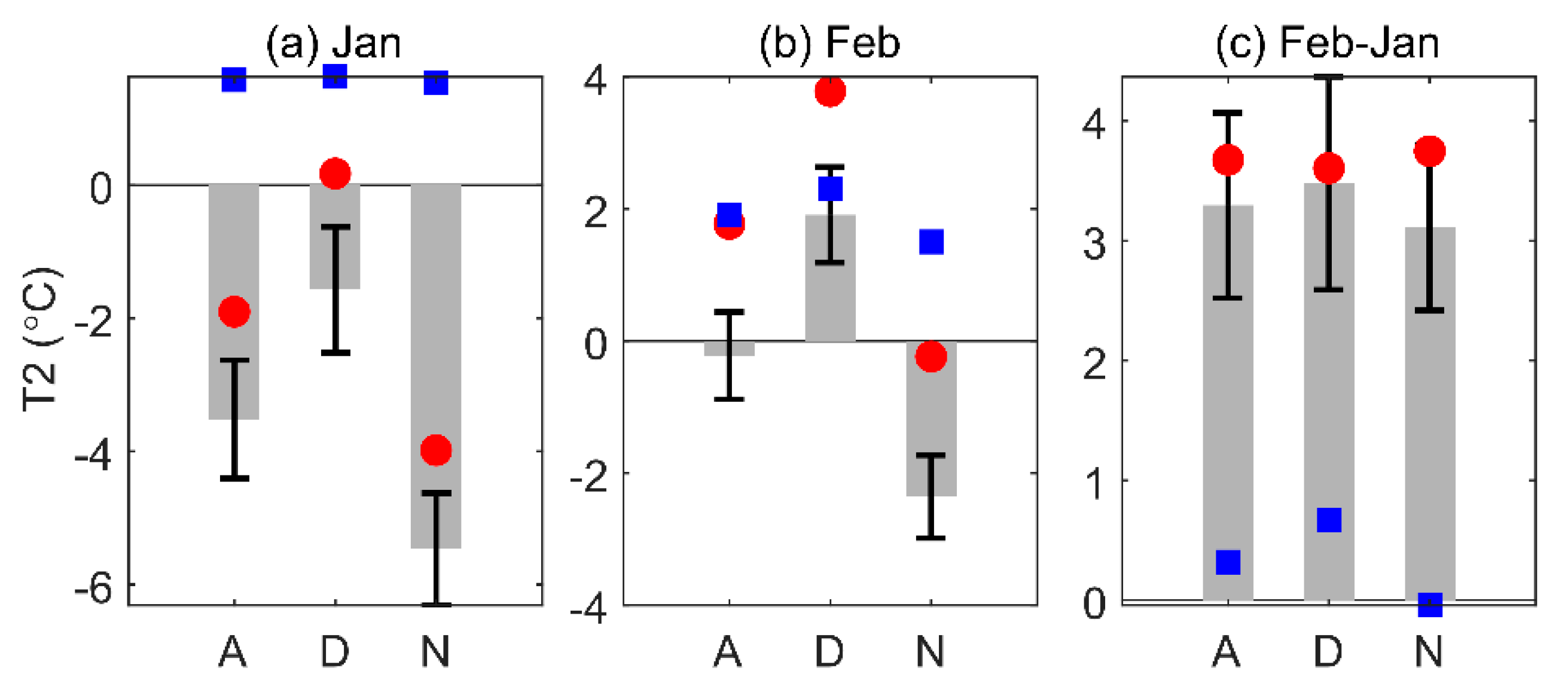
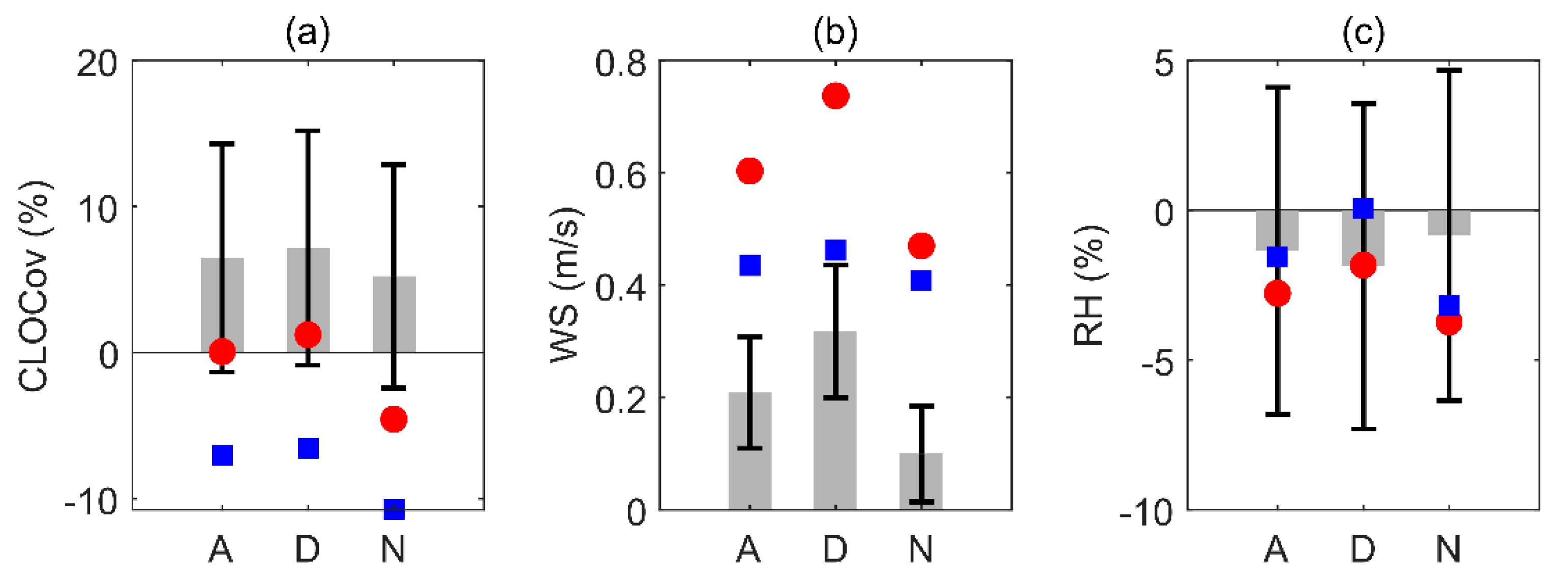
| January | February | Percentage | ||
|---|---|---|---|---|
| PM2.5 | All day long | 99.0 | 60.9 | −38.5% |
| Daytime | 93.4 | 57.4 | −38.6% | |
| Nighttime | 104.6 | 64.4 | −38.4% | |
| SO2 | All day long | 17.4 | 11.3 | −35.1% |
| Daytime | 18.5 | 12.0 | −35.3% | |
| Nighttime | 16.3 | 10.6 | −34.9% | |
| NO2 | All day long | 50.3 | 26.2 | −48.0% |
| Daytime | 45.6 | 22.7 | −50.2% | |
| Nighttime | 55.1 | 29.7 | −46.2% | |
| CO | All day long | 1.61 | 1.08 | −33.1% |
| Daytime | 1.58 | 1.06 | −32.6% | |
| Nighttime | 1.65 | 1.09 | −33.6% |
| RMAPS vs. OBS | EC vs. OBS | ||||||
|---|---|---|---|---|---|---|---|
| January (°C) | February (°C) | Change* (%) | January (°C) | February (°C) | Change (%) | ||
| 24 h | Tmean | 1.31 | 1.08 | −17.3 | 1.08 | 0.88 | −18.5 |
| Tmax | 2.50 | 2.26 | −9.8 | 2.02 | 1.73 | −14.5 | |
| Tmin | 2.37 | 1.86 | −21.6 | 2.09 | 1.65 | −20.9 | |
| 48 h | Tmean | 2.65 | 2.19 | −17.4 | 2.33 | 1.95 | −16.3 |
| Tmax | 3.84 | 3.38 | −12.0 | 3.59 | 3.05 | −15.0 | |
| Tmin | 3.32 | 2.68 | −19.3 | 2.75 | 2.25 | −18.1 | |
| 72 h | Tmean | 3.77 | 3.25 | −13.8 | 3.38 | 3.07 | −9.3 |
| Tmax | 4.54 | 4.05 | −10.8 | 5.10 | 4.65 | −8.8 | |
| Tmin | 3.62 | 3.02 | −16.5 | 3.35 | 3.02 | −9.7 | |
Disclaimer/Publisher’s Note: The statements, opinions and data contained in all publications are solely those of the individual author(s) and contributor(s) and not of MDPI and/or the editor(s). MDPI and/or the editor(s) disclaim responsibility for any injury to people or property resulting from any ideas, methods, instructions or products referred to in the content. |
© 2023 by the authors. Licensee MDPI, Basel, Switzerland. This article is an open access article distributed under the terms and conditions of the Creative Commons Attribution (CC BY) license (https://creativecommons.org/licenses/by/4.0/).
Share and Cite
Zhang, Z.; Lei, Y.; Cheng, S. A Study on the Influence of Air Pollution on Temperature Forecast Skill Based on Operational Weather Forecast in BTH Region. Atmosphere 2023, 14, 1229. https://doi.org/10.3390/atmos14081229
Zhang Z, Lei Y, Cheng S. A Study on the Influence of Air Pollution on Temperature Forecast Skill Based on Operational Weather Forecast in BTH Region. Atmosphere. 2023; 14(8):1229. https://doi.org/10.3390/atmos14081229
Chicago/Turabian StyleZhang, Ziyin, Yangna Lei, and Siyu Cheng. 2023. "A Study on the Influence of Air Pollution on Temperature Forecast Skill Based on Operational Weather Forecast in BTH Region" Atmosphere 14, no. 8: 1229. https://doi.org/10.3390/atmos14081229
APA StyleZhang, Z., Lei, Y., & Cheng, S. (2023). A Study on the Influence of Air Pollution on Temperature Forecast Skill Based on Operational Weather Forecast in BTH Region. Atmosphere, 14(8), 1229. https://doi.org/10.3390/atmos14081229







